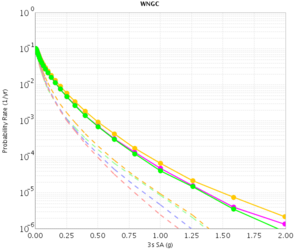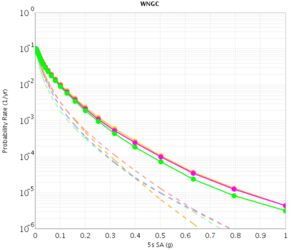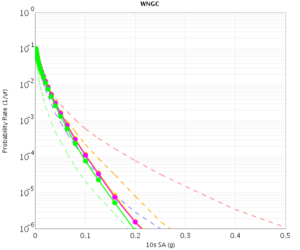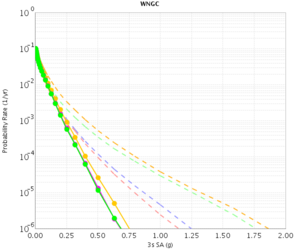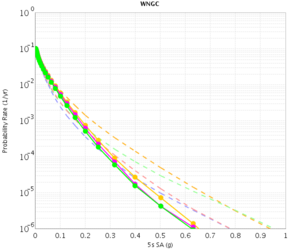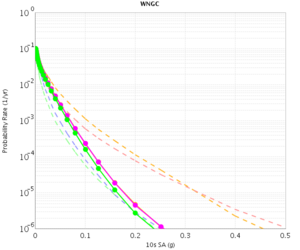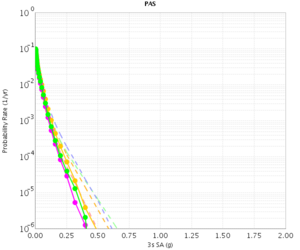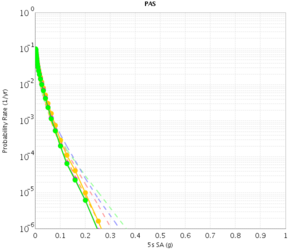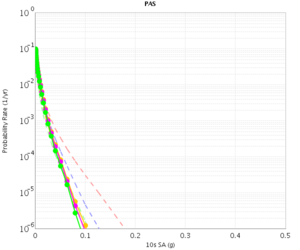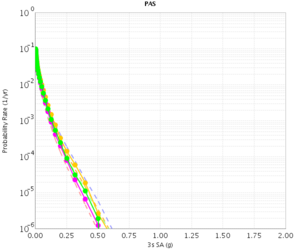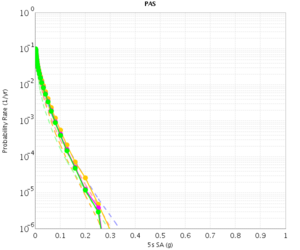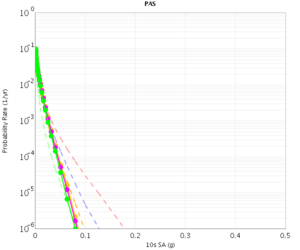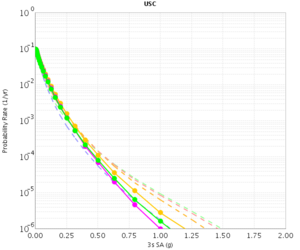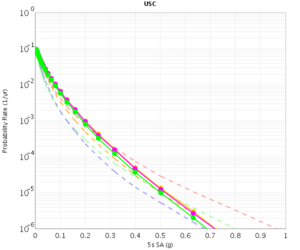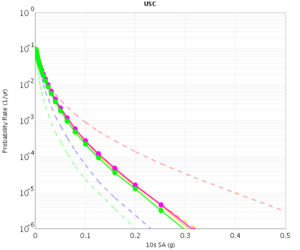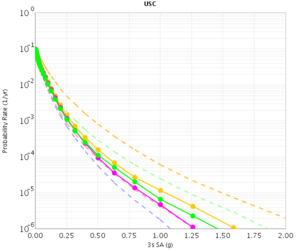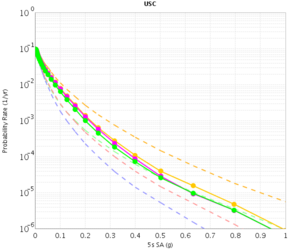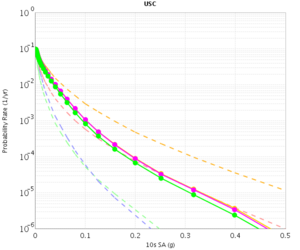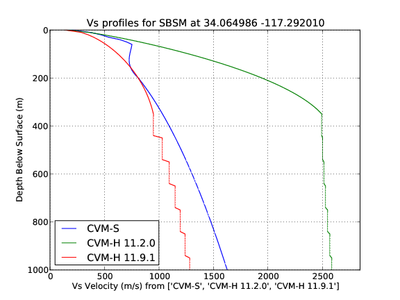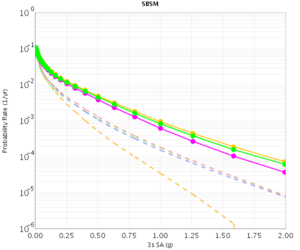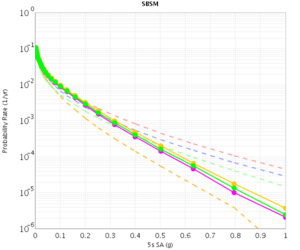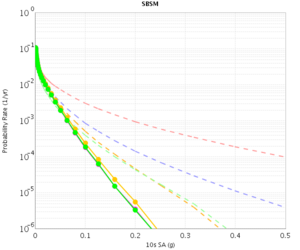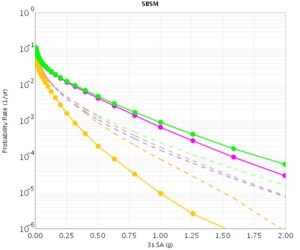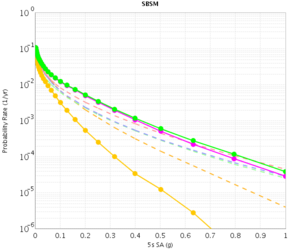Difference between revisions of "CyberShake Study 13.4"
| Line 8: | Line 8: | ||
As of April 23, 2013, 11:21 PM PDT, the stats for the current production run were as follows: | As of April 23, 2013, 11:21 PM PDT, the stats for the current production run were as follows: | ||
| − | {| | + | {| class="wikitable" |
| | | | ||
| RWG CVM-S | | RWG CVM-S | ||
Revision as of 06:28, 24 April 2013
CyberShake Study 13.4 is a computational study to calculate physics-based probabilistic seismic hazard curves using CVM-S and CVM-H with the RWG V3.0.3 SGT code and AWP-ODC-SGT, and the Graves and Pitarka (2010) rupture variations. The goal is to calculate the same Southern California site list (286 sites) in previous CyberShake studies so we can produce comparison curves and maps, and understand the impact of the SGT codes and velocity models on the CyberShake seismic hazard.
During planning stages, we called this CyberShake Study 2.3. However, we have decided to go to a date-based study version numbering scheme. The Study number shows the year.month that the study calculations were started.
Contents
Computational Status
CyberShake study 13.4 was started on Blue Waters on 17 April 2013. Expected Completion date is approximately 15 June, 2013.
As of April 23, 2013, 11:21 PM PDT, the stats for the current production run were as follows:
| RWG CVM-S | RWG CVM-H | AWP CVM-S | AWP CVM-H | Total | |
| Completed | 33 | 31 | 32 | 34 | 130 |
| Percentage | 11.54% | 10.84% | 11.19% | 11.89% | 11.36% |
| Total Sites | 286 | 286 | 286 | 286 | 1144 |
Readiness Review Presentations 10 April 2013
Review Action Items To Be Completed Before Start
- Review from RG
received 12 April - Can we identify 15TB of SCEC storage that we can use as landing space for CS seismograms?
Yes - scec-04. - We need to make 6 TB available on scec-02 for workflow logs.
Can zip Study 2.2 logs once statistics are gathered to save several TB. Can also zip logs from 2011-12 run, once they're identified. 2 TB have been cleared, enough to start. - Can we find estimates of mysql db storage capacity to determine whether our data volume will cause problems?
Research suggests MySQL performance is mostly a function of disk space and memory. - We will capture detailed workflow timing and performance information. What performance metrics can we gather during the Blue Waters runs?
We can wrap in pegasus-kickstart to get those metrics, the jobs are bookended with /bin/date, and we can run a cron job to see how many cores are being used. - How frequently is our CyberShake db on focal backed up to ensure we don’t lose our new results?
We've proposed backing it up before we start, then if there are breaks in runs. - What site/map run order will be used?
All 4 permutations for a site at once, so all 4 maps will progress concurrently. - Contact Blue Waters to help complete run and reduce runtime
Had telecon with Omar to keep him in the loop
Verification
Before beginning Study 2.3 production runs, we first generated hazard curves in all 4 conditions (RWG CVM-S, RWG CVM-H, AWP CVM-S, AWP CVM-H) for 4 test sites, WNGC, PAS, USC, and SBSM. Below are hazard curves comparing these results, along with the previous version of RWG (V3).
WNGC
| 3s | 5s | 10s | |
|---|---|---|---|
| CVM-S | |||
| CVM-H |
PAS
| 3s | 5s | 10s | |
|---|---|---|---|
| CVM-S | |||
| CVM-H |
USC
| 3s | 5s | 10s | |
|---|---|---|---|
| CVM-S | |||
| CVM-H |
SBSM
The CVM-H curves are quite different for RWG V3.0.3 and RWG V3. This is because the V3 curves were made with CVM-H 11.2, whereas the RWG V3.0.3 (and AWP) curves were made with CVM-H 11.9. The update in CVM-H included the addition of the San Bernardino basin, which makes a big impact. You can see this on a velocity profile at SBSM:
| 3s | 5s | 10s | |
|---|---|---|---|
| CVM-S | |||
| CVM-H |
Sites Selection
We are proposing to run 286 sites around Southern California. Those sites include 46 points of interest, 27 precarious rock sites, 23 broadband station locations, 43 20 km gridded sites, and 147 10 km gridded sites. All of them fall within the Southern California box except for Diablo Canyon and Pioneer Town. You can get a CSV file listing the sites here. A KML file listing the sites is available here.
Computational and Data Estimates
We are planning to use Blue Waters and Stampede for this calculation. We plan to calculate 286 sets of 2-component SGTs for each of RWG CVM-S, RWG CVM-H, AWP CVM-S, AWP CVM-H for a total of 1144 sets of SGTs.
We estimate the following requirements for each system. Data estimates are for generated data we may want to keep (SGTs, seismograms, PSA).
Blue Waters
Use for SGT calculations
572 sets of AWP SGTs x 5000 SUs/set = 2.9M SUs 572 sets of RWG SGTs x 5500 SUs/set = 3.2M SUs Total: 6.1M SUs 1144 sets of SGTs x 40 GB/set = 44.7 TB
Stampede
Use for RWG post-processing and half of AWP
858 sites x 900 SUs/site = 850k SUs 858 sites x 11.6 GB/site = 9.7 TB output data (seismograms, spectral acceleration)
Kraken
Use for half of AWP post-processing
286 sites x 5500 SUs/site = 1.6M SUs 286 sites x 11.6 GB/site = 3.2 TB output data (seismograms, spectral acceleration)
SCEC storage
1144 sites x 11.6 GB/site = 13.0 TB stored output data 1144 sites x 4.9 GB/site = 5.5 TB workflow logs
